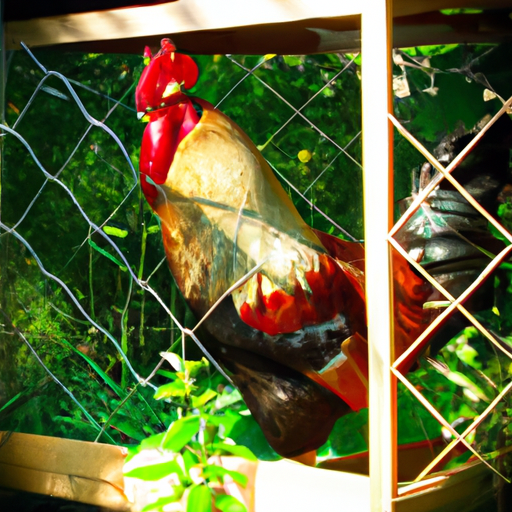
Imagine waking up to the sound of a rooster’s crow, a familiar and sometimes charming sound. However, when that crowing becomes a constant disturbance, it can quickly become less charming and more of a nuisance. In this article, we will explore some simple yet effective ways in which you can reduce noise disturbances caused by a crowing rooster.
Background
Understanding crowing rooster noise
If you find yourself living in a community or neighborhood where roosters are allowed, it is important to understand the nature of crowing rooster noise. Roosters crow to establish their territory, communicate with their flock, and announce the arrival of a new day. The crowing noise can be a source of annoyance for some people, especially when it occurs early in the morning. However, it is important to remember that crowing is a natural behavior for roosters and is an integral part of their daily routine.
Impact of noise disturbances on daily life
Excessive noise disturbances, including crowing roosters, can have a significant impact on your daily life. Constant exposure to loud noises can lead to sleep disturbances, increased stress levels, reduced concentration, and even negative effects on overall health and well-being. It is essential to find ways to minimize the noise disturbances caused by crowing roosters to maintain a peaceful and harmonious living environment.
Legal Considerations
Check local regulations
Before taking any action to address the noise disturbances caused by a crowing rooster, it is important to familiarize yourself with your local regulations. Different jurisdictions may have specific rules and restrictions regarding the keeping and noise levels of roosters. Ensure that you comply with all local laws and avoid any potential legal issues in dealing with the situation.
Seek permission from neighbors or community
While not legally required, seeking permission from your neighbors or community can help foster a spirit of cooperation and goodwill. Engage in open and respectful communication to explain your concerns and discuss potential solutions. By involving your neighbors in the process, you can work together to find a mutually agreeable resolution to mitigate the noise disturbances caused by the crowing rooster.
Environmental Modifications
Construct soundproof coop
One of the most effective ways to reduce noise disturbances caused by a crowing rooster is to construct a soundproof coop. A soundproof coop is specially designed to minimize sound transmission and keep the noise contained within the structure. Use materials such as double-layered walls, acoustic insulation, and sealed windows and doors to create an environment that absorbs and blocks the crowing noise. A well-constructed soundproof coop can significantly reduce the noise that reaches your neighbors’ ears.
Install acoustic barriers
In addition to a soundproof coop, installing acoustic barriers can further reduce noise transmission. These barriers can be placed around the coop or in the direction where the crowing noise is most likely to escape. Use materials such as dense vegetation, sound-absorbing panels, or fences lined with acoustic insulation to create a physical barrier that helps dampen the sound waves and prevent them from reaching neighboring properties.
Utilize natural obstructions
Another environmental modification to consider is utilizing natural obstructions to reduce the impact of crowing rooster noise. Planting dense shrubs or trees around the coop can act as a natural sound buffer and help absorb some of the noise. Additionally, positioning the coop in an area with existing structures, such as a barn or shed, can help block and redirect the sound, minimizing the disturbance to nearby residents.
Behavioral Interventions
Modifying rooster’s routine
Modifying the rooster’s routine can be an effective way to minimize noise disturbances. Roosters are often more inclined to crow in the early morning hours. By adjusting their feeding and sleeping schedule, you can encourage them to stay quiet during the times when the noise would be most disruptive. Gradually shifting their routine to a later time may help reduce the amount of crowing that occurs during the early morning, allowing for a more peaceful start to the day.
Provide distractions
Keeping roosters occupied with distractions can help divert their attention from crowing excessively. Provide them with enriching toys, puzzles, or even a small flock of hens. These distractions can engage their natural behaviors and help reduce their inclination to crow as frequently. Ensuring that roosters have a stimulating and fulfilling environment can help minimize noise disturbances caused by crowing.
Train the rooster
Training your rooster can help teach them appropriate behavior and reduce excessive crowing. Use positive reinforcement techniques to reward quiet behavior and discourage crowing. Training sessions can include commands such as “quiet” or “no crow,” coupled with treats or praise when the rooster stops crowing. Be patient and consistent in your training efforts, as it may take some time for the rooster to respond and learn new behaviors.
Physical Modifications
Use anti-crow collars
Anti-crow collars are specialized devices designed to reduce the volume and frequency of a rooster’s crowing. These collars wrap around the rooster’s neck and apply gentle pressure, inhibiting the full extension of the neck and limiting the intensity of the crow. It is important to note that anti-crow collars should only be used under the guidance of a veterinarian to ensure the safety and well-being of the rooster.
Implement hen separation
Roosters often crow in response to their hens’ vocalizations. By implementing hen separation, you can reduce the triggers for crowing. Create separate enclosures for the hens, allowing them to remain in sight but reducing direct vocal interactions. This separation can help minimize the rooster’s instinctual need to communicate with the hens and, in turn, decrease crowing behaviors.
Opt for surgical interventions
In extreme cases where other measures have proven ineffective, surgical interventions such as crow reduction surgery can be considered. This procedure involves reducing the size or altering the vocal structures of the rooster to dampen the crowing noise. However, surgical interventions should only be pursued after consulting with a veterinarian and considering all other available options. It is essential to prioritize the well-being and ethical treatment of the rooster in any decision.
Sound Masking Techniques
White noise machines
White noise machines emit a steady sound that helps mask background noises, including crowing roosters. Place a white noise machine in your bedroom or in areas where the rooster noise is most bothersome. The continuous sound provided by the machine can help drown out the crowing and create a more peaceful and sleep-friendly environment.
Play soothing sounds or music
Playing soothing sounds or music can have a calming effect on both humans and animals. Consider using nature sounds, classical music, or any other calming audio to help mask the crowing noise. The soothing sounds can act as a distraction while creating a more pleasant atmosphere in your home or outdoor space.
Utilize background noise
Introducing background noise, such as a fan or air purifier, can help mitigate the impact of crowing rooster noise. These devices produce a gentle humming or whirring sound that can help mask the rooster’s crowing. Place them strategically in areas where the noise is most noticeable or use them to create a consistent background noise throughout your space.
Adopting Different Breeds
Explore quieter breeds
If noise disturbances caused by crowing roosters are a major concern, consider exploring quieter breed options. Some breeds naturally produce less crowing noise or exhibit less frequent crowing behavior. Research different chicken breeds known for their calm and quiet nature to find one that aligns with your preferences and local regulations.
Consider crossbreeding options
Crossbreeding roosters with breeds known for their quieter characteristics can also help reduce crowing noise. Working with a knowledgeable breeder or consulting with poultry experts can provide guidance on which breeds to cross to achieve the desired results. However, it is important to remember that genetics can be unpredictable, and results may vary when attempting crossbreeding.
Consulting Professionals
Contact veterinarians
When facing challenges with noisy roosters, it is beneficial to seek guidance from veterinarians who specialize in poultry. Veterinarians can assess the rooster’s health and behavior to identify any underlying issues and provide appropriate recommendations. They can also advise on sound management techniques and provide further insight into modifying the rooster’s behavior.
Seek advice from animal behaviorists
Animal behaviorists are experts in understanding and modifying animal behavior. Consulting with an animal behaviorist can help you better understand the motivations behind the rooster’s crowing and develop effective strategies to address it. They can provide guidance on training techniques, environmental modifications, and behavioral interventions tailored to your specific situation.
Alternative Housing Options
Find off-site coops
If noise disturbances caused by crowing roosters continue to be a significant issue despite your best efforts, consider finding off-site coops. Look for local farms or agricultural communities that provide accommodations for roosters. These alternative housing options can ensure that the rooster can continue to live and thrive in an environment where crowing noise is accepted and not disruptive to nearby residents.
Participate in local poultry relocation programs
Some communities have poultry relocation programs in place to assist in finding suitable homes for roosters. These programs aim to match roosters in need of relocation with individuals or organizations looking to add roosters to their flocks. By participating in such programs, you can find a new home for your rooster where the crowing noise will not pose a disturbance to your immediate neighbors.
Communication and Cooperation
Discuss concerns with neighbors
Open and respectful communication with your neighbors is key to addressing crowing rooster noise disturbances. Schedule a time to discuss your concerns and potential solutions with them. By actively involving your neighbors in the conversation, you can foster a cooperative spirit and work together to find a suitable resolution that takes everyone’s needs into account.
Educate community about rooster noise
Promote understanding and empathy within your community by educating others about the nature of crowing rooster noise and the challenges it may pose. Organize community meetings, distribute informational materials, or use social media to share knowledge about roosters’ behavior and potential solutions. By increasing awareness, you can create a more understanding and supportive environment for those dealing with crowing roosters.
In conclusion, reducing noise disturbances caused by crowing roosters requires a multi-faceted approach. By understanding the nature of crowing rooster noise and considering the legal considerations and environmental modifications available, you can take proactive steps towards minimizing the impact. Additionally, behavioral interventions, physical modifications, sound masking techniques, and exploring alternative breeds or housing options can all contribute to creating a more peaceful and harmonious living environment. Consulting professionals and fostering open communication and cooperation within your community are essential steps in finding a suitable resolution for all parties involved. Remember, by addressing crowing rooster noise in a friendly and respectful manner, you can maintain a positive relationship with your neighbors while ensuring a quieter and more serene living environment for everyone.







